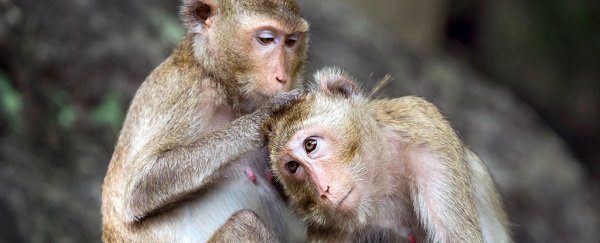We humans think we're so special. To determine what sets us apart from the rest of the animal world, scientists investigate features that might be uniquely human, such as self-awareness or language.
But every now and then, a new finding throws the narrative, leaving us to wonder what those truly unique human traits really are. In a new study, neuroscientists have knocked down another assumption by discovering a network in the monkey brain that's exclusively devoted to analysing social interactions.
Most primates, including humans, are highly social animals, and are able to effortlessly analyse social interactions. But we don't know much about the neural networks that allow monkeys to do this kind of sophisticated processing.
Scientists from the Rockefeller University in New York used an fMRI (functional magnetic resonance imaging) scanner to look at four rhesus macaque brains while they were watching different videos.
The viewing material included scenes of monkeys engaging in social behaviours, monkeys doing stuff by themselves, or just sitting still. For the control part of the experiment, here were videos with various objects (such as toys) instead of monkeys, again either interacting, or moving independently, or being stationary.
The researchers scanned monkeys' brains while they were watching the videos to find out which parts of the brain showed the greatest activity in response to different content - especially the videos with other monkeys as opposed to objects.
As expected, they found that any video with a monkey in it as opposed to a video with an object activated a groove in the brain called the superior temporal sulcus (STS).
Because we have a pretty good idea of the general organisation of a primate brain, the scientists knew this to be an area involved in processing information about bodies and faces.
Depending on the type of interaction shown in the video, activity was more pronounced either in parts of the brain dedicated to processing faces, or to processing body areas.
They also found that the mirror neuron system - part of the brain that activates when monkeys see others grasping objects - doesn't just react to social interactions, but also helps process object interactions.
When they were first discovered, mirror neurons (humans have them, too) were speculated to be the brain part that explains human empathy, but much of that hype has since died down.
The most surprising find came when the team analysed brain scans pertaining specifically to social interaction videos - it turns out that there appears to be a brain network in rhesus macaques that only 'lights up' on an fMRI when there's a social situation to be analysed.
"Social interactions, but not physical ones, activated a large set of brain regions beyond the category-selective networks and the mirror neuron system," the researchers write in the paper.
This means that monkeys have dedicated brain circuitry for social interactions alone - something scientists have not observed before.
"That was both unexpected and mind-boggling," lead researcher Winrich Freiwald said in a press statement.
Humans have something called 'theory of mind' - our effortless ability to understand what other people might be thinking, and how those mental states affect their behaviour. It's a sort-of "I know that you know" situation.
The researchers argue that the exclusive social interactions network they found in the monkeys could be similar to what humans have for our own theory-of-mind circuitry.
If that's indeed the case, there are clues here for understanding the "deep evolutionary heritage" of the human capacities that make us such highly successful social animals.
But we'll also need more research to further specify what that newly discovered brain network in rhesus macaques does, and where we can draw the line between their brain functions and ours.
The study was recently published in Science.
